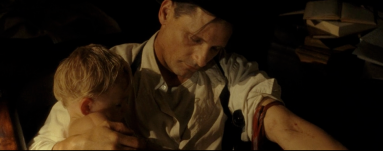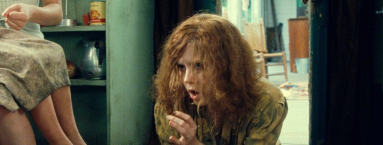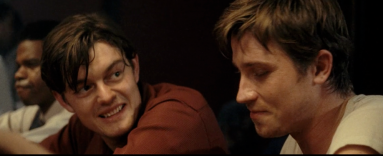By remaking the novel, On The Road makes Kerouac's mistakes all over again
"In the papers they called it [the] 'Beat insurrection,' words I never spoke. Being a Catholic, I believe in order, tenderness, and piety." - Jack Kerouac, 1968
What is often least interesting about literary film adaptations is the attempt to be literal. There is a kind of exactitude that readers of popular fiction seek – the meticulous transference of Tolkein, for instance, from text to image. Such a fidelity fixates Walter Salles's On the Road, which deeply penetrates the atmospherics of Jack Kerouac's novel, with only rare deviations from the original story. Capturing the raw, greasy pubescence of the Beat Generation's originary mythology, the film accentuates the libido of an intensely homosocial sphere. This sphere extends to various "magical negroes," like Walter, the saxophone player, while it keeps women silent and empty at the margins, only to be folded back to the center in exchange for sex.
Unsurprisingly, the film drifts from the novel only to make the mythology more explicit – clarifying that the characters Sal Paradise, Dean Moriarty, Carlo Marx, and Old Bull Lee are indeed Kerouac's pseudonyms for himself, Neal Cassady, Allen Ginsberg, and William S. Burroughs. In keeping with Kerouac's Cassady obsession, screenwriter Jose Rivera focuses on Sal and Dean, leaving the more peripheral Carlo Marx and Bull Lee as stripped away caricatures of their respective literary-historical counterparts. Carlo (Tom Sturridge) is no more than a parody of Ginsberg: boy-crazy and suicidal. His dialogue is riddled with jokes about getting stoned. Not once in the film is Carlo's last name mentioned, while in the novel, 'Marx' figures a political lineage for Ginsberg, as a more precise critique of the novel's McCarthyist backdrop.
In Viggo Mortenson's portrait of Bull Lee, there’s a complicated vision of Burroughs that I wish had been more important in the film's narrative. Bull is the literary patriarch of these “long lost brothers,” a heroin addict and father to two children. There simply isn't the space in the film to engage Jane, Bull's wife, as a substantive character – instead, Amy Adams’s portrayal is reduced to fragility and hysterics. Throughout these brief glimpses into Bull and Jane’s bizarre domesticity, there is a biographical insinuation never quite acknowledged: Several months after Kerouac completed On the Road, in 1951, Burroughs shot and killed his wife Joan Vollmer in a drunken William Tell act. Within the film and novel alike, it’s only her tragic fate that seeps through. Adams’s Joan is all frizzy hair and dilated pupils; nowhere is the woman who Brenda Knight describes as the “whetstone against which the main Beat writers – Allen, Jack, and Bill – sharpened their intellect... her strong mind and independent nature helped bulldoze the Beats toward a new sensibility.”
***
Shortly after the publication of On the Road, the inevitability of a Hollywood adaptation seemed certain to Kerouac – it was only a matter of casting and financing. Within months, he wrote a letter to Marlon Brando. “You play Dean and I'll play Sal (Warner Bros. mentioned I play Sal) and I'll show you how Dean acts in real life,” he proposed. “I [want] you to play the part because Dean (as you know) is no dopey hotrodder but a real intelligent (in fact Jesuit) Irishman.” From Kerouac's descriptions, the film project would only further the ambiguities of fact and fiction, of history and myth, which are so integral to his novel. For Kerouac, it is more a question of what makes it to the pages and what gets left behind, than of the veracity of what he called the “Duluoz Legend” – the series of novels which followed On the Road, including The Subterraneans, The Dharma Bums, Desolation Angels, and Big Sur. If the Proustian dimensions of these texts weren't already clear, Kerouac's unremitting invocations of Swann's Way all but beg of his reader to make such a literary comparison. And yet, as in his courtship of Brando, Kerouac strongly conceived of literature as a part of the American culture industry – the machinery of what he called the Beat Generation.
Brando never replied to Kerouac, and the film was never made. By now, the specter of Kerouac's would-be Hollywood production is a part of the Beat mythology, and perhaps a source of obligation for the film, which marks the first adaptation of the novel after fifty-five years. More specifically, the film seems challenged by its obligation to Kerouac's genealogy, organized around a theory of “Beat.”
In 1959, Kerouac writes:
Maybe since I'm supposed to be the spokesman of the Beat Generation (I am the originator of the term, and around it the term and the generation have taken shape) it should be pointed out that all this 'Beat' guts therefore goes back to my ancestors who were Bretons who were the most independent group of nobles in all old Europe and kept fighting Latin France to the last wall... Breton, Wiking, Irishman, Indian, madboy, it doesn't make any difference, there is no doubt about the Beat Generation, at least the core of it, being a swinging group of new American men intent on joy... the Beat Generation goes back to the wild parties my father used to have at home in the 1920s and 1930s in New England that were so fantastically loud nobody could sleep for blocks around and when the cops came they always had a drink.
Kerouac conceives of beat through this generational sequentiality. While he is concerned with claiming the term's authorship, he is also fixated on etymological lineages to 'beatitude' and the 'beatific.' By the late 1950s, he begins to articulate the Beat Generation as a revolution – but particularly, as a “revolution of manners.” While the word 'beat,' he explains, “originally meant poor, down and out, deadbeat, on the bum, sad, sleeping in subways,” he describes the revolution as the “[inclusion] of people who do not sleep in subways but have a certain gesture, or attitude, which I can only describe as a new more.” He proceeds to extend the genealogy to more icons who fit this revolution of manners: Brando, Dane Clark, Humphrey Bogart, Peter Lorre, James Dean, Montgomery Clift, Elvis Presley...
The film On the Road imagines Kerouac's narrative as a love story between Dean and Sal far more than a Beat genealogy. In a broad sense, I find this interpretation convincing, but to retrieve it from the novel involves working against some of its deeply ingrained ideologies of masculinity, which the film achieves to a very minimal extent. The Beats’ homosocial erotics emerge almost strictly during the film's frequent sexual interludes. The film instrumentalizes actress Kristen Stewart's desperate need to abandon the innocence of her Twilight stardom beginning with her first appearance, topless and post-coital. Besides this eroticism, however, the film begins to draw out a particular dilemma in Kerouac's portrait of Dean – and in Sal's insistence on Dean's status as a tragic hero, whose womanizing, alcoholism, and general irresponsibility all somehow stem from the absence of his father during childhood, in which Sal repeatedly finds forgiveness. Although actor Garrett Hedlund brings the necessary jockish charm and handsomeness to Dean, he also asserts (or perhaps cannot withhold) a misogyny and unreflexiveness which cut through Sal's exonerative narration. In part because of Hedlund's rather irresolute performance, the film reaches a point of utter confusion in its final act.
While the film fails to critique Kerouac's redemption of Dean in the novel, this failure seems symptomatic of a more general evaporation of history. The film's rich atmospherics come to obscure any resources for a historical critique of its characters, and particularly, of Dean. As with Ginsberg and Burroughs, what is left of the narrative's historicity are vacuous fragments of icons and Americana. And yet, this vacuousness is also inherent to Kerouac's “revolution of manners,” in which there are:
...beatnik routines on TV, starting with satires about girls in black and fellows in jeans with snap-knives and sweat-shirts and swastikas tattooed under their armpits, it will come to respectable m.c.s of spectaculars coming out nattily attired in Brooks Brothers jean-type tailoring and sweater-type pull-ons, in other words, it's a simple change in fashion and manners, just a history crust.
Ultimately, the film has the same problem that Kerouac did: it is out of this notion of history as “fashion and manners” that redemption and revolution are rendered separate, even contentious pursuits. In the novel, Dean is redeemed precisely because of his misery. Out of all those who have suffered from his sins, it is Dean who has suffered the most. For the film, however, it is precisely because of history that such an ending should not go without certain gestures toward the present – today, Dean's brand of individualist anti-authoritarianism seems more akin to Ayn Rand's “morality of self-interest,” than to any fellow Beats. In its representation of pre-revolutionary conditions, the film casts onto the Beat mythology a foreclosure of the counterculture: in Dean, the Neoliberal “post-1960s” is already, latently achieved.
***
As he aged, Kerouac's politics of redemption became more apparently counter-revolutionary. In 1968, a year before his death, the author made his last television appearance on William F. Buckley's Firing Line. During the interview, as Ann Charters writes, Kerouac “slouched in a chair with a cup of whisky at his side and said that the war in Vietnam was being fought so that both North and South Vietnamese could have access to American jeeps.” Already by the early 1960s, the idea of 'Beat' was not only extended to the satires on TV, but to a political vision that Kerouac resisted. The Beat Generation was an aesthetic movement for Kerouac, whose notion of aesthetics begins apart from politics, as what he understood to be religiosity. Shortly after the publication of On the Road, the Beat Generation – and the ideology of 'beat' – started to unravel, precisely at the precipice of resistance and transformation.
I wonder whether there is a point in preserving the Beat Generation as a stable concept – whether Kerouac's genealogy should be re-established for what he called “that last, pale generation which will not know the answers either.” In the 1960s, the politicization of Beat culture was also an attempt to preserve the notion of a generation. Today, this attempt should be more a matter of salvaging from the Beats as a vast outburst of cultural productions, without reasserting the structure of patriarchy, the fetishization of race and poverty – without, essentially, the downfall of the King of the Beats. This is a pursuit of redemption; not of Kerouac's redemption, but of what remains latent and unexpressed in his mythology.
Over the last several years, the period piece industry of Hollywood has turned to the Beat Generation a few times, but this production of On the Road reflects the most extreme determination to return to the Beats. The nature of this return, however, still remains a construction of Kerouac's Beat Generation: a past without futurity, a revolution without transformation. While haunted by the painful rhapsodics of James Franco's Ginsberg impression, the recent adaptation of “Howl” is far more interesting in its treatment of shared material. For all its shortcomings, Howl ambitiously grasps toward a poetic filmic imaginary, multiplying into different animated representations of the poem, disjointed retrospections of its conception, as well as reenactments of the poem's Six Gallery Reading and eventual censorship trial. Within this proliferation, the film makes space for links to the present, but the result is a failed containment of Ginsberg's insurrectionary vision: “Mad generation! down on the rocks of Time! Real holy laughter in the river! They saw it all! the wild eyes! the holy yells! They bade farewell! They jumped off the roof! to solitude! waving! carrying flowers! Down to the river! into the street!” Overwrought and occasionally rather unbearable, the film rouses from Ginsberg's poetry a kind of schizophrenia while resisting the nostalgic register that pervades On the Road, among others.
The novel On the Road occludes the insurrectionism that, regardless of the intentions of Howl filmmakers Rob Epstein and Jeffrey Friedman, emerges from the revolutionary orientation of Ginsberg's poem. For Kerouac, the road provides a narrative structure which denies the Whitmanian, transhistorical invitation made by Ginsberg “into the streets.” The road is teleological, a masculinist trajectory of becoming, routed by frontierism. Throughout the Duluoz Legend, the road is the figure of Duluoz's bipolar vacillation between the East and West coasts, Buddhism and Catholicism, sobriety and alcoholism. And at the end of the road, the character is paralyzed by his inability to cross into the ocean – the space of sublime redemption – as in the final chapter of Big Sur, a poem entitled “Sea.” Throughout the production of this Legend, Kerouac elaborates a narrative of self-destruction, which is also a history of his own cultural and political displacement.
The return to Kerouac seems by now both exorbitant and incredibly crucial, entirely a matter of execution. As a film, On the Road is not beholden to the novel’s nostalgic intonations, nor to Kerouac's patriarchy of long-lost brothers. Instead, the film might have attempted something more comparable to Mad Men, which delineates the gradual unmasking and ideological collapse of its anti-hero, Don Draper – an archetype of the 1950s, encountered in the 1960s. While Mad Men's periodization of the 1960s has its own problems, the series develops a far more complicated historiography than On the Road, which depicts the prescience of the Beat Generation through generic nostalgia. Although aspects of the film were quite revelatory – the blatantness of its homoeroticism, the sharp yet brief glimmers of feminism in its array of muses – the revelation becomes, by the last scene, eclipsed by the romance, and reabsorbed by a Hollywood formula.




